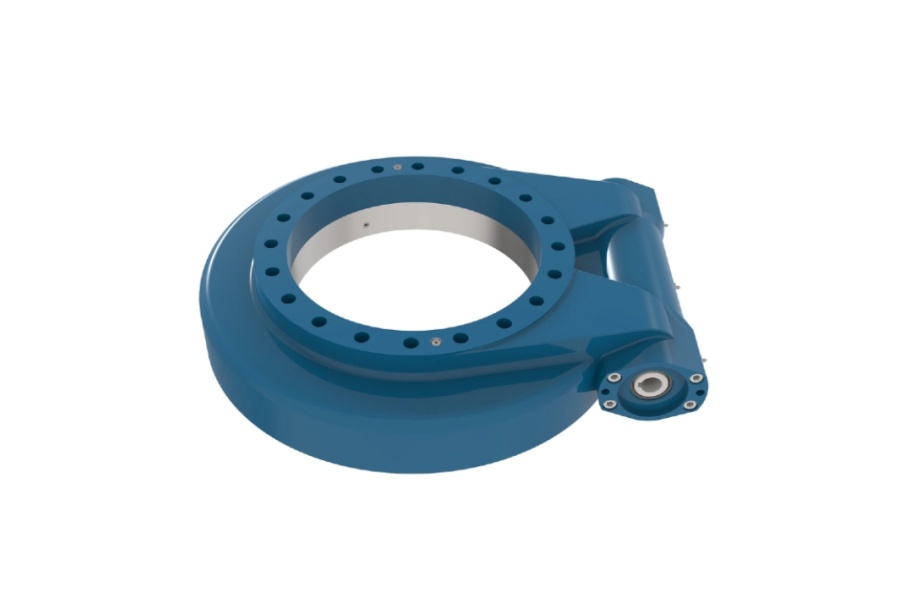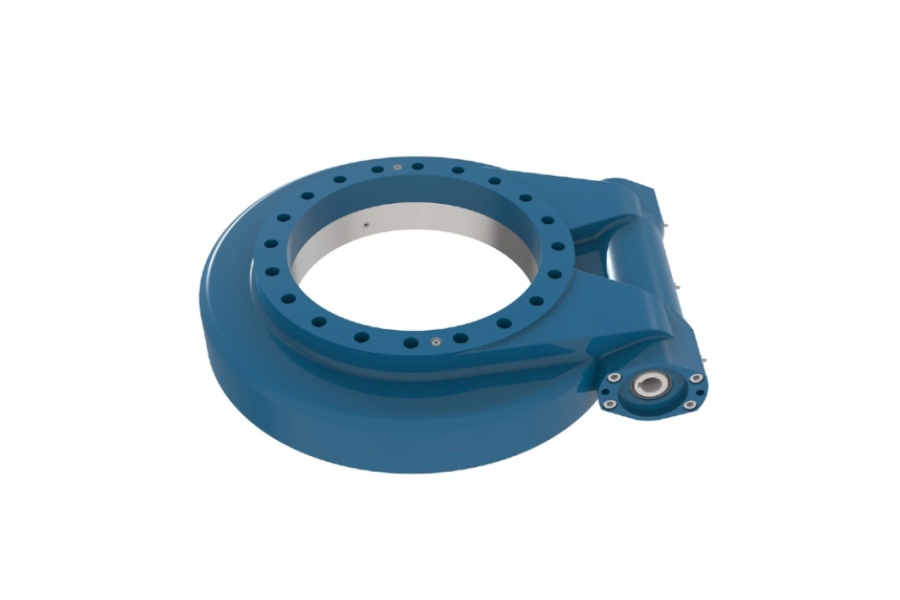
Different Applications Of Different Slew Drives
What Is Slew Drive
Slew Drive is a compact, self-contained gearbox that provides rotational force and precise positioning for a wide range of heavy-duty equipment. At its core, a slew drive integrates a slewing bearing with a gear mechanism—most commonly a worm gear, but also spur gears in some designs—and is often bundled with an integral motor, hydraulic or electric, and a sealing system. The primary function of a slew drive is to convert the input torque from the motor into a slow, powerful, and controlled output rotation, all while supporting substantial axial, radial, and moment loads. The worm gear, when used, provides a natural braking effect and high reduction ratio in a single stage, making it exceptionally difficult for the load to back-drive the system, thus ensuring safety and stability. This combination of load-bearing capacity and controlled motion in a single unit makes slew drives indispensable in applications where space is limited, and performance cannot be compromised. They are the workhorses behind the smooth and reliable movement seen in solar trackers, cranes, excavators, radar antennas, and countless other machines that define modern industrial and technological landscapes.

Different Applications Of Different Slew Drives
The application of a specific type of slew drive is dictated by the unique requirements of the machinery it powers. The choice between a worm gear, double worm, or spur gear design hinges on factors such as required efficiency, load capacity, resistance to backlash, operational speed, and environmental conditions.
Worm Gear Slew Drive applications are perhaps the most widespread due to their excellent balance of performance, compactness, and inherent self-locking capability. The key characteristic of a worm gear system is that the worm can easily turn the gear, but the gear cannot turn the worm, providing a built-in locking mechanism that is vital for safety in many applications. This makes them ideal for use in solar tracking systems, where panels need to be precisely positioned to follow the sun's path throughout the day and must remain firmly locked in place to resist wind loads. They are equally critical in the construction industry, powering the boom movement of compact crawler cranes and the slewing function of excavators, where holding a heavy load steady is paramount. Other common applications include man lifts and aerial work platforms for precise positioning of the basket, and heavy-duty industrial rotary tables used in manufacturing and machining processes.
Double Worm Slew Drive applications are found in scenarios demanding enhanced reliability, superior load distribution, and drastically reduced backlash. As the name implies, this design incorporates two worm gears spaced 90 or 180 degrees apart, engaging with the same internal gear on the bearing. This symmetrical arrangement balances the load across the gear, minimizing stress and wear on individual components, which leads to a longer service life and higher overall torque capacity. The dual-worm design is particularly effective at eliminating backlash, the slight amount of play between gear teeth, which is critical for applications requiring extreme precision and positional accuracy. Consequently, double worm slew drives are the preferred choice for high-performance radar and satellite communication antennas, where any unwanted movement can distort signals. They are also used in sophisticated telescope mounts for astronomical observation, heavy-duty wind turbine pitch and yaw control systems that must withstand unpredictable forces, and advanced robotic welding arms where precision is non-negotiable.
Spur Gear Slew Drive applications are specialized and are chosen primarily for their high efficiency and ability to handle higher rotational speeds. Unlike the worm gear's sliding contact, spur gears operate with a rolling contact, which generates less heat and friction, leading to higher mechanical efficiency. This efficiency translates to lower power requirements from the motor for the same output torque. However, a significant drawback is that spur gear designs are not self-locking; they can be back-driven by the load. Therefore, an external braking system is always required to hold the load in position, adding complexity to the system. Their primary application is in wind turbine yaw systems, where the large rotor diameter requires a drive that can efficiently adjust the nacelle's position with minimal energy loss. They are also found in certain types of material handling equipment, such as large stackers and reclaimers, and in some industrial mixers and agitators where continuous rotation and higher speeds are more critical than a self-locking feature.
Slew Drive Characteristics
The effectiveness of a slew drive in its application is defined by a core set of mechanical and performance characteristics. Understanding these traits is essential for proper selection and integration into a larger system. First and foremost is its exceptional Load Capacity. A quality slew drive is engineered to manage a complex combination of loads simultaneously. This includes axial loads (forces parallel to the axis of rotation), radial loads (forces perpendicular to the axis), and moment loads (tilting forces). The integrated slewing bearing is specifically designed and rated for these multi-directional forces. The second critical characteristic is its High Reduction Ratio and Output Torque. The gear mechanism, especially a worm gear, provides a significant speed reduction from the input motor to the output rotation. This results in a massive increase in output torque, allowing a relatively small motor to control and move extremely heavy loads with precision.
Another defining feature, particularly of worm gear designs, is Self-Locking Capability. The angle of the worm is designed to be shallow enough that the friction between the worm and the gear prevents back-driving. This acts as an automatic brake, ensuring the load remains stationary when the motor is not powered, which is a crucial safety function. Furthermore, Precision and Control are hallmarks of a well-made slew drive. They are designed for smooth, low-speed operation with minimal vibration, allowing for accurate positioning. While some backlash is inherent in any gear system, high-quality manufacturing and designs like the double worm drive minimize this play to near-zero levels for critical applications. Finally, Robustness and Durability are built into their DNA. Slew drives are constructed from high-strength, hardened steels and are equipped with advanced sealing systems to protect the internal gearing from contaminants like dust, water, and other abrasive particles. This ensures reliable operation and a long service life even in the most demanding and harsh environments, from offshore wind farms to dusty construction sites.
Slew Drive Applications
The versatility of slew drives, owing to their compact design and powerful performance, has led to their adoption across a vast spectrum of industries. In the Renewable Energy sector, they are absolutely indispensable. They form the core actuation technology in solar tracker systems, enabling photovoltaic panels to follow the sun, thereby increasing energy output by up to 30% compared to fixed arrays. In wind power, slew drives are used in both the yaw system (to rotate the nacelle to face the wind) and the pitch system (to adjust the angle of the blades for power control). The Construction and Heavy Equipment industry is another major beneficiary. Every time you see an excavator rotate its upper structure or a crawler crane lift and swing a load, a powerful slew drive is at work. They provide the torque and stability needed for these machines to operate safely and efficiently on job sites around the world.
Industrial Automation and manufacturing rely on slew drives for precision motion control. They are found in rotary index tables used in machining centers, robotic welding and assembly arms, and large industrial mixers. Their ability to provide precise angular positioning under load makes them ideal for automated processes. In Defense and Aerospace, the requirements for reliability and accuracy are extreme. Slew drives are used to position radar antennas for air traffic control and military surveillance, to steer satellite communication dishes, and in various guidance and tracking systems. The Medical and Scientific fields also utilize these drives in advanced equipment such as CT and MRI scanners, where smooth and precise rotation is critical for imaging, and in large telescopes for astronomical research. Finally, they appear in Marine and Transportation applications, such as deck cranes on ships and cable laying equipment, demonstrating their unparalleled adaptability.
What Affects Slew Drive Price
The price of a slew drive is not a single figure but a variable determined by a confluence of engineering, material, and market factors. Understanding these can help in budgeting and selecting a drive that offers the best value for a specific application. The most significant factor is the Drive Size and Load Capacity. Larger drives built from more material to handle immense loads (e.g., for a multi-megawatt wind turbine or a massive port crane) will command a significantly higher price than a smaller unit designed for a small solar tracker or a compact crane. The Gear Type and Design Complexity also plays a major role. A standard single worm gear drive is generally more economical. A double worm gear drive, with its additional components, precision machining, and assembly requirements for reduced backlash, will be more expensive. A spur gear drive, while sometimes simpler, may require the added cost of an integrated external brake, affecting the total system price.
The Quality of Materials and Manufacturing is a critical cost driver. Drives manufactured using high-quality, hardened alloy steels, through processes like case hardening or induction hardening, will have superior wear resistance and longevity but come at a higher initial cost. The precision of the gear grinding and the quality of the heat treatment directly impact performance, noise, and lifespan. Furthermore, the Type and Quality of Sealing directly influence price and suitability for harsh environments. Standard lip seals are cost-effective for general use, but advanced labyrinth seals or proprietary sealing solutions for extreme environments (offshore, mining, food-grade) add to the cost. Additional Ancillary Components such as the integrated motor (be it hydraulic, servo, or standard electric), built-in sensors for feedback, and specialized mounting flanges or lubrication systems will all increase the overall unit price. Finally, Order Volume and Customization affect cost. Standard, off-the-shelf drives are cheaper, while a fully custom-designed slew drive for a unique application requires significant engineering resources, prototyping, and testing, leading to a higher per-unit cost, though economies of scale apply for large production runs.
Slew Drive Supplier
For engineers and procurement specialists seeking reliable and high-performance slew drive solutions, LYRADRIVE stands as a prominent and trusted supplier in the global market. The company has established a strong reputation for engineering excellence and manufacturing precision-driven components that meet the rigorous demands of diverse industries. LYRADRIVE's product portfolio encompasses a wide range of standard and custom-designed slew drives, including robust worm gear, precision double worm, and efficient spur gear configurations. Each unit is manufactured using superior-grade materials and subjected to stringent quality control processes to ensure exceptional durability, optimal performance, and long service life even in the most challenging operating conditions. Beyond supplying standard products, LYRADRIVE distinguishes itself through its strong technical support and customer collaboration, working closely with clients to develop tailored solutions that perfectly integrate into their specific machinery and applications. This commitment to quality, innovation, and customer satisfaction makes LYRADRIVE a go-to partner for those who cannot compromise on the critical components that drive their equipment.



